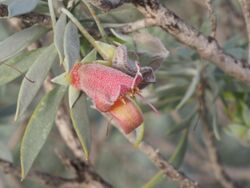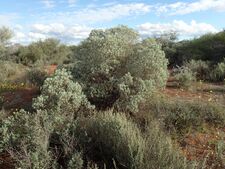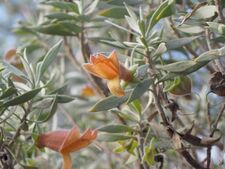Biology:Eremophila pterocarpa subsp. pterocarpa
| Silver poverty bush | |
|---|---|

| |
| E. pterocarpa subsp. pterocarpa leaves and flowers | |
| Scientific classification | |
| Kingdom: | Plantae |
| Clade: | Tracheophytes |
| Clade: | Angiosperms |
| Clade: | Eudicots |
| Clade: | Asterids |
| Order: | Lamiales |
| Family: | Scrophulariaceae |
| Genus: | Eremophila |
| Species: | W.Fitzg.[1]
|
| Subspecies: | E. p. subsp. pterocarpa
|
| Trinomial name | |
| Eremophila pterocarpa subsp. pterocarpa | |
Eremophila pterocarpa subsp. pterocarpa is a plant in the figwort family, Scrophulariaceae and is endemic to Western Australia. It is a common and widespread large shrub or small tree with grey leaves and sepals and orange, pink or yellow petals.
Description
Eremophila pterocarpa subspecies pterocarpa is a shrub or small tree growing to 0.8–5 metres (3–20 ft) high. The branches are prominently ribbed and the leaves are linear to lance-shaped, 20–40 millimetres (0.8–2 in) long and 2–5.6 millimetres (0.08–0.2 in) wide with a pointed end. The leaves and stems are covered with powder-like short, matted hairs. Most of the leaves have their bases twisted so that the leaves face horizontally.[2][3]
The flowers are red to yellow, lack spots and are arranged singly in the leaf axils on a stalk which is 10–16 millimetres (0.4–0.6 in) long. There are 5 sepals which are narrow egg-shaped to triangular and of approximately equal lengths. The petals, which give the flowers their colour are 14–24 millimetres (0.6–0.9 in) long and joined in a tube with 5 lobes at the end. As with the leaves, the sepals and petals have a dusty covering of short, fine hairs. Flowering occurs between June and September and is followed by fruits which are flattened and dry with papery wings.[2][3][4]
Taxonomy and naming
The species was first formally described in 1904 by William Vincent Fitzgerald in the Journal of the Royal Society of Western Australia. When Robert Chinnock reviewed the genus, he recognised a subspecies - E. pterocarpa subsp. acicularis as well as the type subspecies pterocarpa.[1][5]
Distribution and habitat
Subspecies pterocarpa occurs between the Cape Range, Shark Bay and Meekatharra areas where it grows in sandy clay or soils derived from limestone, in flats or salty sites.[2][4][6]
Conservation
Subspecies pterocarpa is listed as "not threatened" by the Government of Western Australia Department of Parks and Wildlife.[4]
References
- ↑ 1.0 1.1 "Eremophila pterocarpa subsp. pterocarpa". APNI. https://id.biodiversity.org.au/instance/apni/619244. Retrieved 5 September 2015.
- ↑ 2.0 2.1 2.2 Chinnock, Robert J. (2007). Eremophila and allied genera : a monograph of the plant family Myoporaceae (1st ed.). Dural, NSW: Rosenberg. pp. 481–482. ISBN 9781877058165.
- ↑ 3.0 3.1 Brown, Andrew; Buirchell, Bevan (2011). A field guide to the eremophilas of Western Australia (1st ed.). Hamilton Hill, W.A.: Simon Nevill Publications. p. 227. ISBN 9780980348156.
- ↑ 4.0 4.1 4.2 "Eremophila pterocarpa subsp. pterocarpa". FloraBase. Western Australian Government Department of Parks and Wildlife. https://florabase.dpaw.wa.gov.au/browse/profile/15170.
- ↑ Fitzgerald, William Vincent (1904). "Additions to the West Australian Flora". Journal of the West Australian Natural History Society 1: 28–29. https://www.biodiversitylibrary.org/item/173540#page/30/mode/1up. Retrieved 16 March 2016.
- ↑ Paczkowska, Grazyna; Chapman, Alex R. (2000). The Western Australian flora : a descriptive catalogue. Perth: Wildflower Society of Western Australia. p. 341. ISBN 0646402439.
Wikidata ☰ Q27928295 entry
 |



